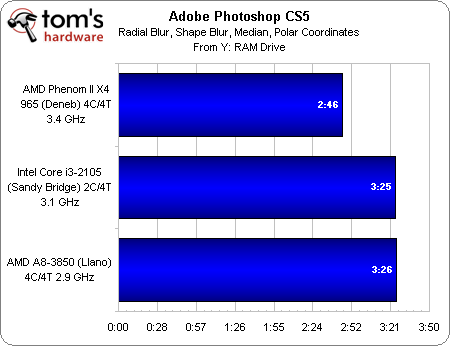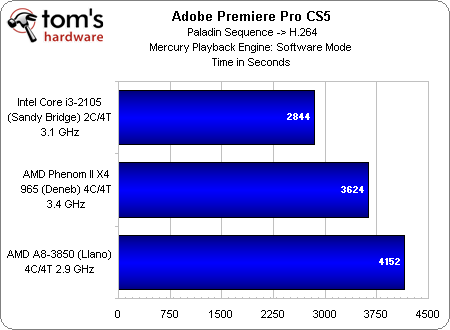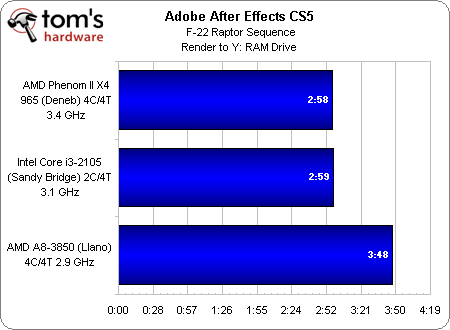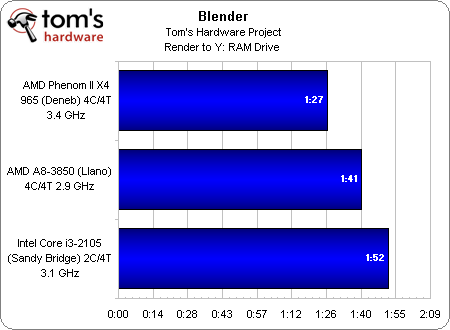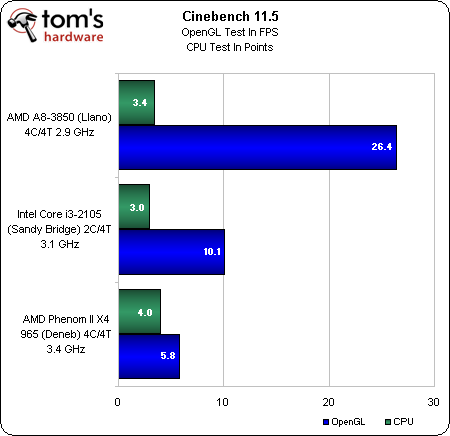AMD A8-3850 Review: Llano Rocks Entry-Level Desktops
Earlier this month we previewed AMD's Llano architecture in a notebook environment. Now we have the desktop version with a 100 W TDP. How much additional performance can the company procure with a loftier thermal ceiling and higher clocks?
Benchmark Results: Content Creation
Gaming was destined to be the most exciting segment of our benchmark results. From here on out, we’re forced to face the limitations of recycling the Stars architecture, and the compromise AMD had to make in cutting L3 cache to make room for graphics.
Our threaded Photoshop test favors AMD’s quad-core Deneb architecture at the heart of Phenom II X4. Intel’s dual-core i3-2105 takes second place, with the quad-core A8-3850 one second behind.
Premiere Pro CS5 sees a massive speedup when you install a CUDA-capable discrete graphics card and accelerate the Mercury Playback Engine. None of these platforms include that functionality, though, so we’re left with a software-based encode. Interestingly, the dual-core Core i3-2105 does best here, followed by the Phenom II X4 and the A8-3850.
Suspicious that Premiere Pro was being starved for memory with the quad-core CPUs installed, we replaced our 4 GB DDR3-2133 kit with an 8 GB DDR3-1333 kit and tried the test again. A result of 3556 seconds on the Phenom II X4 proves that additional memory doesn’t help AMD’s architecture perform better; this title simply seems better-optimized for Intel’s processors.
After Effects seems to either miss Deneb's L3 cache or its clock rate advantage, as AMD’s A8-3850 suffers in comparison to the Phenom II X4 965 Black Edition. Intel’s Core i3-2105 doesn’t need as much speed or as much L3 to keep up with the Phenom, though.
The quad-core processors are vindicated in Blender, where the Phenom II X4 at 3.4 GHz finishes in first place and is followed by the A8-3850 in second. Intel’s Core i3-2105 falls into last place, its two cores unable to keep pace.
Expectedly, the strongest performer in the graphics discipline is AMD’s A8-3850 and the fastest processor is the quad-core Phenom II X4. Incidentally, the Llano-based APU beats Intel’s Core i3-2105 in both metrics.
Get Tom's Hardware's best news and in-depth reviews, straight to your inbox.
Current page: Benchmark Results: Content Creation
Prev Page Benchmark Results: World Of Warcraft: Cataclysm (DirectX 9 And 11) Next Page Benchmark Results: Productivity-
SteelCity1981 So then what's the point of getting the Turbo Core versions when they are going to be Turbo Clocked slower then the none Turbo Clocked versions...Reply -
cangelini SteelCity1981So then what's the point of getting the Turbo Core versions when they are going to be Turbo Clocked slower then the none Turbo Clocked versions...Reply
They don't want you to see better performance from a cheaper APU in single-threaded apps by pushing Turbo Core further ;-) -
Known2Bone i really wanted see some amazing gains in the content creation department what with all that gpu power on chip... oh well games are fun too!Reply -
ivan_chess I think this would be good for a young kid's PC. It would be enough to run educational software and a web browser. When he grows up to be a gamer it would be time to replace the whole machine anyway.Reply -
DjEaZy ... it's may be not the greatest APU for desktop... but it will be a powerful thingy in a laptop... the review was nice... but in the gaming department... would be nice to see a standard 15,x'' laptop resolution tests @ 1366x768... or something like that...Reply -
Mathos Actually if you want good DDR3 1600 with aggressive timings, the Ripjaws X series memory that I have does DDR3 1600 at 7-8-7-24 at 1.5v, not all that expensive when it comes down to it either.Reply -
Stardude82 This makes little sense. An Athlon II X3 445 ($75) and a HD 5570 ($60, on a good day you can get a 5670 for the same price) would provide better performance for the same price ($135) and not have to worry about the RAM you use.Reply
So is AM3+ going to be retired in favor of FM1 in the near future? Why are there chipset at all? Why isn't everything SOC by now?
Otherwise this is a very good CPU. If AMD has used 1 MB level 2 caches in their quads when they came out with the Deneb Propus die, they would be much more competitive. -
crisan_tiberiu stardude82This makes little sense. An Athlon II X3 445 ($75) and a HD 5570 ($60, on a good day you can get a 5670 for the same price) would provide better performance for the same price ($135) and not have to worry about the RAM you use. what about power consumption?Reply
